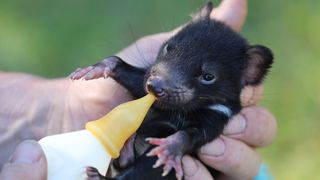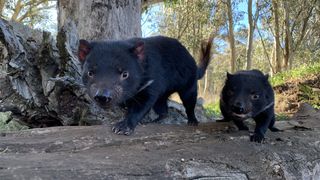After 3,000 years, Tasmanian devils return to mainland Australia
Restoring devils to mainland ecosystems could also help other threatened species.

The pitter-patter of Tasmanian devil feet was heard in the wild of mainland Australia for the first time in 3,000 years, after a group of devils was released in Barrington Tops, a protected national park about 120 miles (200 kilometers) north of Sydney.
Tasmanian devils (Sarcophilus harrisii), the world's largest carnivorous marsupial, have been long gone from most of the Australian continent, and until now the only remaining wild populations were on the island of Tasmania. Mainland devils were likely outcompeted by dingos, the wild dogs that were introduced to Australia at least 3,500 years ago, and which are now considered a pest species.
However, a decade of dingo eradication has offered Tasmanian devils a second chance. By clearing out dingos and reintroducing devils to Barrington Tops, conservationists hope to not only reestablish thriving wild populations of the iconic marsupials, but to also help protect other native species that are threatened by invasive predators, according to a statement released on Oct. 5 by Global Wildlife Conservation (GWC).
Related: Australia's struggling marsupial: Photos of the Tasmanian devil
Aussie Ark, a wildlife nonprofit in Australia, has been breeding and studying Tasmanian devils for more than a decade, with the goal of eventually reintroducing devils into the wild once conditions were sustainable for their survival, according to the statement. For the recent release, Aussie Ark partnered with GWC and WildArk, another wildlife conservation nonprofit; they released 11 Tasmanian devils on Sept. 10.
Tasmanian devils are black-furred and stocky with blunt muzzles and short limbs, measuring about 22 to 26 inches (55 to 65 centimeters) long and standing about 12 inches (30 cm) high at the shoulder, according to the Australian Museum. Devils on the island of Tasmania were safe from dingos, which never got a foothold there. But Tasmania's devils face another deadly threat: a highly contagious and fatal cancer known as devil facial tumor disease (DFTD). First detected in the 1990s, the cancer has since wiped out about 90% of Tasmania's devils, leaving only 25,000 in the wild, according to the GWC statement.
Conservation experts in Tasmania work to isolate healthy devils from sick ones, and to breed healthy populations. But there are limited opportunities on the island for reintroducing the healthy devils and keeping them separated from infected devils, "and it's impossible as yet to eradicate the disease," GWC president Don Church told Live Science.
Sign up for the Live Science daily newsletter now
Get the world’s most fascinating discoveries delivered straight to your inbox.
Because the cancer only spreads through direct facial contact between devils — usually when they nip each other's faces while competing over prey — a cancer-free devil population on Australia's mainland would therefore be safe from infection, Church said.

Bringing Tasmanian devils back to the Australian continent could also help address another dire ecological threat posed by domestic cats and foxes; neither species is native to the continent, and both were introduced to Australia in the 18th century by European colonizers. Dingos once helped keep cat and fox populations somewhat under control, but as dingos were eradicated over the last decade, the number of cats and foxes has skyrocketed — and their impact on native wildlife is devastating. Cats in Australia kill more than 2 billion wild animals each year; in just one day, Australia's millions of cats kill an estimated 1.3 million birds, 1.8 million reptiles and over 3.1 million mammals, Live Science previously reported.
But introducing devils might deter these invasive predators or disrupt their hunting habits, Church said.
"In the presence of devils, cats are less able to hunt at night, because devils are nocturnal," he explained. "So they shift to hunt during the day, and they're not as effective when they hunt during the day."
As for foxes, European colonizers tried to introduce them to Tasmania at least six times and failed every attempt — possibly because Tasmanian devils were already established there.
"There was never a scientific study done as to why it never took — the habitat seemed perfect for them, the prey was there," Church said. But one hypothesis is that the presence of the Tasmanian devil prevented foxes from gaining a foothold.

Though Tasmanian devils are carnivorous, they would be less detrimental to native biodiversity than cats or foxes because devils are marsupials. As such, they have a lower metabolic rate than placental carnivores, and don't need to eat as often, Church said. Devils also prefer to eat animals that are already dead, which further reduces their impact on an ecosystem's resources, he added.
"That Barrington Tops area has about 40 species that we know of that are in trouble," Church said. "Our hope is that the presence of the devils will be an ecological solution, a contribution to addressing the main driver of extinction on the Australian continent, which is the presence of feral cats and foxes. We hope long-term that the presence of the devil on the landscape will help keep the numbers of those introduced species at bay, and it'll be a natural, self-replicating solution to the problem."
After a few weeks, scientists will recapture some of the released devils and fit them with radio transmitter harnesses; the animals can't wear collars because "they don't really have a neck," Church said. Surveys and camera traps will provide additional data on how the devils are adapting to their new home. But the real proof of their success will arrive around June 2021, if new devil joeys are spotted peeping out of their mothers' pouches, Church told Live Science.
"That'll be a great indicator that the population can survive on its own," he said.
Originally published on Live Science.

Mindy Weisberger is an editor at Scholastic and a former Live Science channel editor and senior writer. She has reported on general science, covering climate change, paleontology, biology, and space. Mindy studied film at Columbia University; prior to Live Science she produced, wrote and directed media for the American Museum of Natural History in New York City. Her videos about dinosaurs, astrophysics, biodiversity and evolution appear in museums and science centers worldwide, earning awards such as the CINE Golden Eagle and the Communicator Award of Excellence. Her writing has also appeared in Scientific American, The Washington Post and How It Works Magazine.
